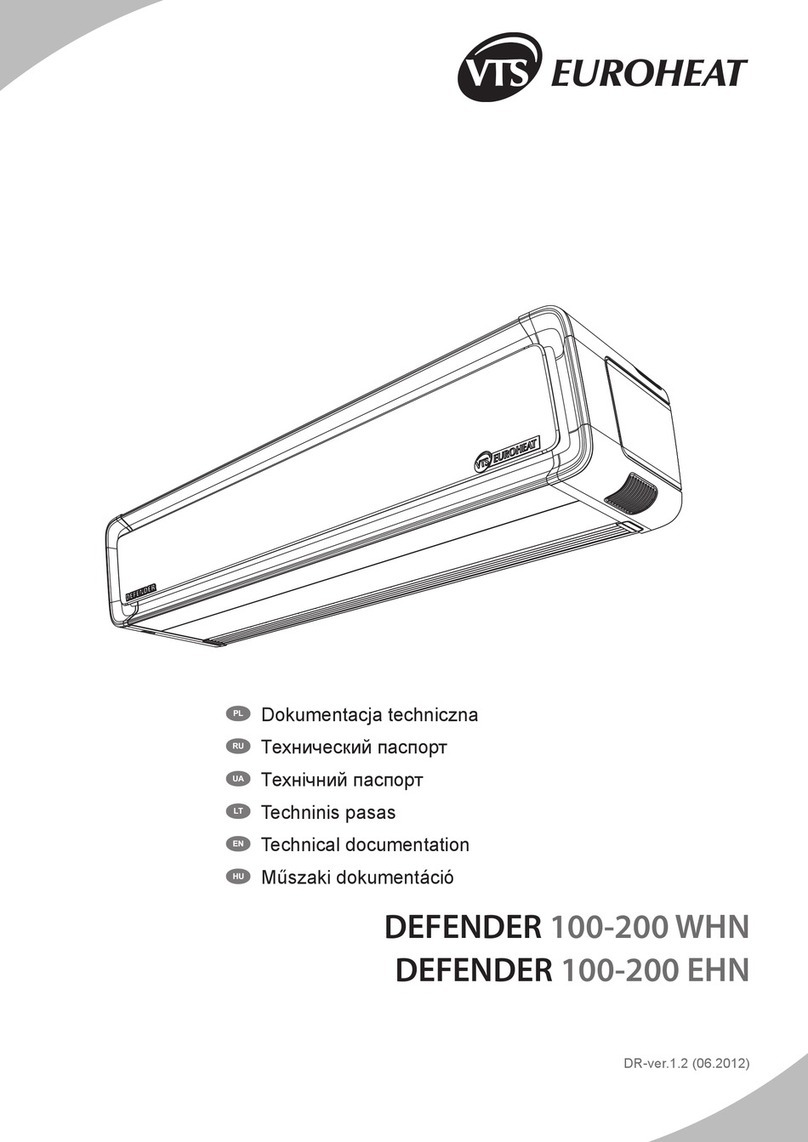
EN
ES:
TABLE OF CONTENTS
1. INTRODUCTION ...............................................................................................................................................................................................................................................................................................5
1.1. PRECAUTIONS, REQUIREMENTS, RECOMMENDATIONS ....................................................................................................................................................................................................................5
1.2. TRANSPORT ..............................................................................................................................................................................................................................................................................................5
1.3. INITIAL STEPS TAKEN BEFORE THE INSTALLATION ............................................................................................................................................................................................................................5
2. STRUCTURE, INTENDED USE, PRINCIPLE OF OPERATION .......................................................................................................................................................................................................................5
2.1. INTENDED USE .........................................................................................................................................................................................................................................................................................5
2.2. PRINCIPLE OF OPERATION .....................................................................................................................................................................................................................................................................5
2.3. STRUCTURE (DEFENDER 100-200 WHN, EHN) .....................................................................................................................................................................................................................................5
2.4. OVERALL DIMENSIONS (DEFENDER 100-200 WHN, EHN) ...................................................................................................................................................................................................................6
3. ASSEMBLY ........................................................................................................................................................................................................................................................................................................6
3.1. ASSEMBLY/ DISASSEMBLY OF SIDE COVERS ......................................................................................................................................................................................................................................7
3.2. ASSEMBLY OF DEVICE .............................................................................................................................................................................................................................................................................7
3.2.1. HORIZONTAL ASSEMBLY DIRECTLY ON THE WALL. ...................................................................................................................................................................................................................7
3.2.2. HORIZONTAL ASSEMBLY WITH USING INSTALATION HANDLES. ..............................................................................................................................................................................................8
3.2.3. VERTICAL ASSEMBLY DIRECTLY ON THE WALL..........................................................................................................................................................................................................................8
3.2.4. VERTICAL ASSEMBLY WITH USING INSTALATION HANDLES.....................................................................................................................................................................................................9
3.3. ASSEMBLY AND INSTALLATION GUIDELINES ........................................................................................................................................................................................................................................9
4. ELEMENTS OF AUTOMATICS .......................................................................................................................................................................................................................................................................11
5. START-UP, OPERATION, MAINTENANCE .................................................................................................................................................................................................................................................... 11
5.1. START-UP/PUTTING INTO OPERATION ................................................................................................................................................................................................................................................11
5.2. OPERATION AND MAINTENANCE .........................................................................................................................................................................................................................................................11
6. SERVICING .....................................................................................................................................................................................................................................................................................................12
6.1. PROCEDURE IN CASE OF DEFECTS ....................................................................................................................................................................................................................................................12
6.2. COMPLAINT PROCEDURE .....................................................................................................................................................................................................................................................................13
7. INDUSTRIAL SAFETY INSTRUCTION ...........................................................................................................................................................................................................................................................13
8. TECHNICAL DATA ..........................................................................................................................................................................................................................................................................................23
8.1. WATER AIR CURTAIN – DEFENDER 100-200 WHN ..............................................................................................................................................................................................................................23
8.2. ELECTRIC AIR CURTAIN – DEFENDER 100-200 EHN ...........................................................................................................................................................................................................................25
9. ATTACHMENTS ..............................................................................................................................................................................................................................................................................................28
9.1. ELECTRICAL DIAGRAM OF DEFENDER 100-200 WHN.........................................................................................................................................................................................................................29
9.2. ELECTRICAL DIAGRAMS OF DEFENDER 100-200 EHN.......................................................................................................................................................................................................................30
9.3. ELECTRICAL DIAGRAMS OF CONNECTION OF DEFENDER 100-200 WHN CONTROL SYSTEM - CONTROL WITH USING A WALLMOUNTED DX CONTROLLER .........................................35
9.4. ELECTRICAL DIAGRAMS OF CONNECTION OF DEFENDER 100-200 WHN CONTROL SYSTEM - CONTROL WITH USING A WALL-MOUNTED DX CONTROLLER
AND A DOOR SENSOR..................................................................................................................................................................................................................................................................................36
9.5. ELECTRICAL DIAGRAMS OF CONNECTION OF DEFENDER 100-200 EHN CONTROL SYSTEM - CONTROL WITH USING A WALLMOUNTED DX CONTROLLER ..........................................37
9.6. ELECTRICAL DIAGRAMS OF CONNECTION OF DEFENDER 100-200 EHN CONTROL SYSTEM - CONTROL WITH USING A WALL-MOUNTED DX CONTROLLER
AND A DOOR SENSOR..................................................................................................................................................................................................................................................................................38
10. TECHNICAL INFORMATION TO THE REGULATION (EU) NO 327/2011 IMPLEMENTING DIRECTIVE 2009/125/EC ..............................................................................................................................39
11. SERVICING ....................................................................................................................................................................................................................................................................................................41
TABLA DE CONTENIDOS
1. INTRODUCCIÓN .............................................................................................................................................................................................................................................................................................14
1.1. PRECAUCIONES, REQUERIMIENTOS, RECOMENDACIONES ...........................................................................................................................................................................................................14
1.2. TRANSPORTE ..........................................................................................................................................................................................................................................................................................14
1.3. MEDIDAS ADICIONALES TOMADAS ANTES DE LA INSTALACIÓN .....................................................................................................................................................................................................14
2. ESTRUCTURA, USO PREVISTO, PRINCIPIO DE FUNCIONAMIENTO .......................................................................................................................................................................................................14
2.1. USO PREVISTO .......................................................................................................................................................................................................................................................................................14
2.2. PRINCIPIO DE OPERACIÓN ...................................................................................................................................................................................................................................................................14
2.3. ESTRUCTURA (DEFENDER 100-200 WHN, EHN) .................................................................................................................................................................................................................................14
2.4. DIMENSIONES TOTALES (DEFENDER 100-200 WHN, EHN) ...............................................................................................................................................................................................................15
3. MONTAJE ........................................................................................................................................................................................................................................................................................................15
3.1. MONTAJE/DESMONTAJE DE CUBIERTAS LATERALES .......................................................................................................................................................................................................................16
3.2. MONTAJE DE DISPOSITIVOS .................................................................................................................................................................................................................................................................16
3.2.1. MONTAJE HORIZONTAL DIRECTO AL MURO .............................................................................................................................................................................................................................16
3.2.2. MONTAJE HORIZONTAL CON USO DE SOPORTES DE INSTALACIÓN ....................................................................................................................................................................................17
3.2.3. MONTAJE VERTICAL DIRECTO AL MURO ...................................................................................................................................................................................................................................17
3.2.4. MONTAJE VERTICAL CON USO DE SOPORTES DE INSTALACIÓN .........................................................................................................................................................................................18
3.3. GUÍAS PARA EL MONTAJE E INSTALACIÓN .........................................................................................................................................................................................................................................18
4. ELEMENTOS DE AUTOMATIZACIÓN ............................................................................................................................................................................................................................................................20
5. INICIO, OPERACIÓN Y MANTENIMIENTO ....................................................................................................................................................................................................................................................20
5.1. INICIO/ PUESTA EN MARCHA .................................................................................................................................................................................................................................................................20
5.2. OPERACIÓN Y MANTENIMIENTO ..........................................................................................................................................................................................................................................................20
6. SERVICIO .......................................................................................................................................................................................................................................................................................................21
6.1. PROCEDIMIENTO EN CASO DE DESPERFECTOS ..............................................................................................................................................................................................................................21
6.2. PROCEDIMIENTO DE RECLAMOS ........................................................................................................................................................................................................................................................22
7. INSTRUCCIONES DE SEGURIDAD INDUSTRIAL ........................................................................................................................................................................................................................................22
8. DATOS TÉCNICOS .........................................................................................................................................................................................................................................................................................23
8.1. CORTINA DE AIRE AGUA – DEFENDER 100-200 WHN ........................................................................................................................................................................................................................23
8.2. CORTINA DE AIRE ELÉCTRICA – DEFENDER 100-200 EHN ................................................................................................................................................................................................................25
9. ARCHIVOS ADJUNTOS ..................................................................................................................................................................................................................................................................................28
9.1. ESQUEMAS ELÉCTRICOS DEFENDER 100-200 WHN..........................................................................................................................................................................................................................29
9.2. ESQUEMAS ELÉCTRICOS DEFENDER 100-200 EHN...........................................................................................................................................................................................................................30
9.3. ESQUEMAS ELÉCTRICOS DE LAS CONEXIONES DEL SISTEMA DE CONTROL DEFENDER 100-200 WHN
– CONTROL CON USO DE UN CONTROLADOR MONTADO A LA PARED DX .........................................................................................................................................................................................35
9.4. ESQUEMAS ELÉCTRICOS DE LAS CONEXIONES DEL SISTEMA DE CONTROL DEFENDER 100-200 WHN
– CONTROL CON USO DE UN CONTROLADOR MONTADO A LA PARED DX Y UN SENSOR EN LA PUERTA ......................................................................................................................................36
9.5. ESQUEMAS ELÉCTRICOS DE LAS CONEXIONES DEL SISTEMA DE CONTROL DEFENDER 100-200 EHN
– CONTROL CON USO DE UN CONTROLADOR MONTADO A LA PARED DX .........................................................................................................................................................................................37
9.6. ESQUEMAS ELÉCTRICOS DE LAS CONEXIONES DEL SISTEMA DE CONTROL DEFENDER 100-200 EHN
– CONTROL CON USO DE UN CONTROLADOR MONTADO A LA PARED DX Y UN SENSOR EN LA PUERTA ......................................................................................................................................38
10. INFORMACIÓN TÉCNICA A LA REGULACIÓN (EU) N° 327/2011 APLICACIÓN DE LA DIRECTIVA 2009/125/EC...................................................................................................................................40
11. SERVICIO.......................................................................................................................................................................................................................................................................................................42

































